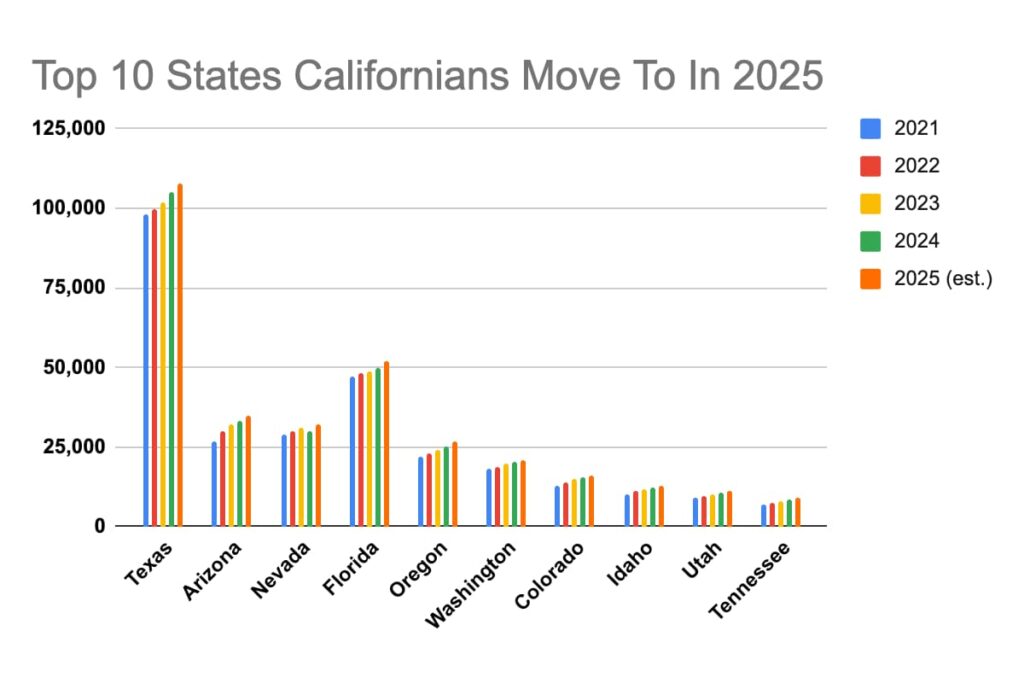
Table of Contents
California Moving Trends: Landlords and Investors Guide
California was once the exclusive home of tech pioneers, movie stars, models, and some of the world’s fastest-growing companies. For decades, millions flocked to the Golden State in search of innovation, opportunity, and the American dream. But today, the conversation is changing. The question is no longer “Who’s moving in?” but rather the more urgent “How many are moving out?”
Every year, hundreds of thousands of residents leave California. The trend is undeniable. On one side, the state is experiencing significant population losses in certain regions, creating new challenges for both communities and businesses. On the other hand, California continues to attract people from abroad, immigrants, international students, and young dreamers who still see the state as a land of opportunity.
This article takes a close look at California’s migration patterns in 2025: who is leaving, where they are going, and who is choosing to stay. We’ll also explore the root causes driving these shifts and what the migration crisis means for landlords, investors, and the broader California housing market.
How Many People Are Leaving California?
At Good Life Property Management, we have seen California continue to lose residents to other states, but the picture is more nuanced than it sounds. According to the U.S. Census Bureau, between 2023 and 2024, about 239,000 more people left California than moved in from other parts of the country.
However, that outflow is offset by gains from abroad. International migration added roughly 150,000 new residents to California during the same period. When combined with natural population growth (more births than deaths), the state’s total population actually grew slightly in 2023, marking its first increase since 2020.
For us at Good Life, these mixed trends matter. The steady domestic out-migration affects local housing demand, while international arrivals and young professionals continue to bring new energy and opportunity to the rental market.
Why Are Californians Moving Out?
At Good Life, we’ve been watching this trend closely, and we see the same story across much of the state. The main reasons people are leaving California are affordability, taxes, and lifestyle flexibility.
Housing and Cost of Living
Housing affordability remains the most significant factor driving residents out of California. Home prices are nearly double the national average, and, according to the California Association of Realtors, the statewide median home price reached $883,640 in September 2025. Renters face similar pressures, with average monthly rents in major metros like Los Angeles and San Francisco above $3,000 (Redfin, 2025).
As we often tell our clients, when families and professionals can find comparable homes for half the cost in places like Texas or Arizona, it’s not surprising that many people are choosing to relocate.
Taxes, Regulation, and Business Climate
California’s high cost of living isn’t limited to housing. The state’s 13.3% top income tax rate (the highest in the nation) adds to the financial strain. Combined with business regulations and insurance costs, some residents and companies are deciding it’s easier to operate elsewhere.
At Good Life, we’ve seen firsthand how these pressures shape investment strategies. Some property owners are expanding portfolios into nearby states, while others focus on optimizing local operations to stay competitive in changing markets.
Remote Work and Lifestyle Flexibility
The rise of remote and hybrid work has given many Californians new flexibility. People can now keep their California-based jobs while living in more affordable states with lower taxes and a better quality of life. The Daily Dive (2025) notes that insurance costs and everyday expenses are pushing even long-time residents to consider moves they wouldn’t have imagined five years ago.
From our perspective at Good Life, this flexibility is reshaping where and how people choose to live. It’s also influencing which markets are showing the strongest rental and investment potential in 2025 and beyond.
Where Are Californians Moving in 2025?
At Good Life Property Management, we pay close attention to where Californians are heading after they move. Most aren’t heading across the country, though. They’re choosing nearby or similarly sunny states that offer lower costs and strong job markets.
Top Destinations for Californians in 2025
According to a 2024–2025 migration study by MoveBuddha, the top destinations for former Californians are Texas, Arizona, and Florida. A similar report from U-Haul also found that California remained one of the top outbound states, with many one-way rentals bound for Texas, Tennessee, and Colorado (U-Haul Growth Index, 2025).
Here’s a quick look at where former Californians are landing:
- Texas: Consistently the top destination thanks to no state income tax, lower housing costs, and growing job markets in Austin, Dallas, and Houston.
- Arizona: Offers warm weather, affordable housing, and proximity to California for those who still commute or visit family.
- Nevada: Popular with retirees and remote workers seeking tax advantages and affordable real estate, especially around Las Vegas and Reno.
- Florida: Appeals to retirees and remote workers looking for sunshine and no state income tax.
What This Means for Property Owners and Investors
For us at Good Life Property Management, these trends primarily affect the California markets we serve. When more residents move out, some areas may see slower rental demand or longer vacancy times. At the same time, regions within California that remain more affordable, such as parts of San Diego County, the Inland Empire, and Sacramento, often attract renters priced out of coastal cities. By tracking these shifts, we help property owners adjust pricing, strengthen tenant retention, and stay competitive in a changing market.

Who Is Leaving California and Who’s Staying?
At Good Life Property Management, we’ve seen that California’s migration story isn’t just about numbers. It’s also about who is leaving and why, and who continues to make this state their home. Recent research from the Public Policy Institute of California (PPIC) found that nearly every demographic group experienced some level of out-migration, but specific trends stand out.
The top three groups who are leaving are:
- Middle-income families. Many are relocating to nearby states or to California’s inland regions in search of more affordable housing and lower living costs.
- Retirees. By selling high-value homes in coastal areas and using the equity to stretch their savings, retirees are moving to lower-cost regions.
- Remote workers. Taking advantage of flexible job arrangements, remote workers are moving out while keeping their California-based salaries.
According to PPIC’s analysis, these groups tend to move to less expensive areas within California or to other western states when possible, seeking a balance between affordability and lifestyle. But despite the outflow, millions of Californians remain and invest in the state.
The top three groups who are staying are:
- Young professionals. The boom in tech, entertainment, and healthcare jobs keeps young professionals and recent college graduates in California.
- Immigrants and international students. According to the U.S. Census Bureau, international migration added more than 360,000 new residents between 2023 and 2024, marking the strongest rebound in several years. Many of these new arrivals come to study or work in industries that remain anchors of California’s economy, such as technology, education, and healthcare.
- Longtime homeowners. Many longtime homeowners benefit from low property taxes through California’s Proposition 13, which keeps their annual increases small. Sometimes, this makes staying in their current home more affordable than buying anywhere else.
The movement of people in and out of California tells a story of balance rather than decline. As housing costs and job opportunities continue to evolve, Good Life Property Management is here to help property owners navigate these changes and stay ahead of the market.
Migration Trends by the Numbers
We are paying close attention to the data behind California’s shifting population. The numbers tell a complex story that shows both continued out-migration and signs of recovery.

California’s Outflow Is Slowing Down
The U.S. Census Bureau estimates that California lost about 239,000 residents to other states between 2023 and 2024. While that’s still a significant number, it’s smaller than the losses seen during the pandemic years. This suggests that the steepest part of the state’s population decline may already be behind us.
International Migration Is Rebounding
During that same period, roughly 150,000 new residents arrived from other countries, helping to offset domestic losses. Many of these newcomers are students, professionals, and families attracted to California’s universities and economic opportunities.
Overall Population Growth Has Returned
After three consecutive years of decline, California’s total population grew slightly in 2023, marking its first increase since 2020. Reuters attributes this growth to higher international arrivals and a modest natural population increase.
As these trends unfold, the effects are becoming clear in California’s housing market. Shifts in where people live, how they work, and what they can afford are reshaping demand across regions. At Good Life Property Management, we see these population changes reflected in rental activity, property values, and investment behavior throughout the state.
How Migration Is Reshaping California’s Housing Market
Migration is reshaping California’s housing landscape in noticeable ways. Coastal cities such as Los Angeles and San Francisco are seeing higher vacancy rates and slower rent growth as more residents relocate to less expensive areas. At the same time, inland markets like Sacramento, Fresno, and the Inland Empire continue to expand, attracting families and renters who want more space and affordability.
For property owners, these shifts mean the market is no longer uniform across the state. According to a 2025 UCLA Anderson Forecast survey, rental growth is expected to remain soft along the coast but stronger in inland regions where construction and demand are rising. Similarly, a May 2025 California rental report found that statewide vacancies reached about 5.4%, the highest since 2020, while active listings climbed to nearly 98,000.
At Good Life Property Management, we see these trends reflected in local markets every day. Areas that remain affordable continue to draw steady demand, while higher-cost regions face longer vacancy times and slower rent growth. For California property owners, understanding where renters are moving and why can make all the difference in maintaining stable returns in a changing market.
As these migration patterns reshape demand across the state, the way people search for homes is changing, too. We’ve noticed that today’s buyers rely on technology more than ever to explore listings, compare options, and make informed decisions before they even step inside a property.
3 Ways California Buyers Are Using Technology in 2025
California’s housing market is evolving not only in where people move but in how they search for homes. At Good Life Property Management, we’ve seen that by 2025, buyers are using technology as a key part of nearly every home-buying decision. From virtual tours to AI-driven recommendations, digital tools now shape how people explore, compare, and purchase properties across the state.
1. Virtual Tours in California Real Estate
Virtual tours are now a standard part of the homebuying process in California. In competitive markets like Los Angeles and San Francisco, buyers expect 3D walkthroughs and high-quality videos before scheduling an in-person visit. We’ve seen that properties with immersive virtual tours attract more attention and convert casual browsers into serious buyers. Convenience and transparency are key, and digital presentation often determines which homes stand out.
2. AI in Home Buying: Personalized Property Searches
Artificial intelligence is reshaping how Californians find homes. Platforms like Redfin and Zillow use AI to recommend listings based on each buyer’s search history, budget, and preferences. These personalized suggestions help buyers narrow their focus and save time, especially in fast-moving markets. We’ve found that this level of customization also changes expectations. Renters and buyers now assume that every property search will be intuitive, efficient, and tailored to their lifestyle.
3. Mobile Real Estate Search in California
More than 60% of California homebuyers now start their search on a smartphone, often scrolling through listings during their commutes or on their lunch breaks. Mobile-friendly platforms have become essential, making it easy to browse photos, take virtual tours, and even schedule showings on the go. For property owners, ensuring that listings display beautifully on mobile devices can make a real difference in visibility and interest.
California Migration Outlook for 2025
Experts anticipate that Californians will continue to relocate to other states in 2025, though the pace of departures is expected to slow compared to recent years. Housing affordability remains the primary reason families, retirees, and remote workers choose to move elsewhere in search of lower costs and more space.
At the same time, international immigration and natural population growth are helping offset these losses. According to the U.S. Census Bureau, California’s total population grew slightly in 2023, marking the first increase since 2020. Unlike the rapid pandemic-era outflow, today’s migration trends show a more balanced and stable demographic pattern.
At Good Life Property Management, we view this stabilization as an encouraging sign. While challenges remain, the state’s strong economy, global connections, and cultural appeal continue to attract new residents and investors.
What California Migration Means for Landlords
California’s shifting migration trends directly impact rental demand, and landlords must adapt to remain competitive. In high-cost coastal markets such as Los Angeles and San Francisco, higher vacancies and slower rent growth call for more strategic pricing and strong tenant-retention efforts.
In contrast, inland areas including Sacramento, Fresno, and the Inland Empire continue to see steady rental demand as families relocate from expensive metros in search of affordability. At Good Life Property Management, we help property owners adjust to these regional differences, whether that means refining marketing, adjusting rental rates, or improving tenant experience.
These shifts underline the importance of flexibility and responsiveness. Landlords who track market trends and adjust quickly are best positioned to maintain consistent occupancy and long-term returns in California’s evolving housing landscape.
Real Stories Behind California’s Exodus
Migration data explains the numbers, but personal stories highlight the motivations behind the move. Each year, families, retirees, and professionals weigh the trade-offs between staying in California and building a more affordable life somewhere else.
The Martinez family from San Jose sold their Bay Area home for $1.2 million and relocated to Phoenix, Arizona. With the proceeds, they bought a larger five-bedroom house with a pool for less than half the cost, reducing their monthly mortgage by nearly 40%.
Linda and Robert, retirees from San Diego, moved to Reno, Nevada, to ease the burden of property taxes and healthcare expenses. They now save over $20,000 a year.
Jason, a remote software engineer from Los Angeles, saw an opportunity when his company went fully remote. Instead of paying $3,200 in rent for a small apartment in Culver City, he moved to Austin, Texas, where he rents a modern downtown loft for $1,900 while keeping his California-level salary.
These stories illustrate that Californians aren’t leaving because they dislike the California lifestyle. They are moving to stretch their budgets, lower financial stress, and improve their quality of life.
Frequently Asked Questions
What state are most Californians moving to?
Texas remains the top destination, with strong job markets and no state income tax. Arizona, Nevada, Florida, and Washington also draw large numbers of movers.
Is California’s population declining?
Domestic outmigration is still negative, but international immigration and natural population growth help stabilize the state’s overall population.
Will Californians keep moving out in 2025?
Yes, though at a slower pace than during the 2021-2022 peak.
Do housing prices fall when people leave California?
Not always. Coastal cities may see slower rent growth or higher vacancy rates, while inland areas often experience price increases as new residents move in.
Why do people stay in California despite the high costs?
Many people stay in California for career opportunities in tech, entertainment, and education, as well as for the state’s climate, culture, and lifestyle advantages.
Final Thoughts
California’s migration patterns show a state in transition. While some residents move away for affordability, others continue to arrive for opportunity. International migration, a strong job base, and ongoing innovation keep the state vibrant and diverse.
At Good Life Property Management, we help property owners adapt to these shifts. By staying informed, pricing strategically, and focusing on tenant satisfaction, landlords can succeed in California’s changing rental landscape.
Contact Good Life Property Management today to maximize your rental income and succeed in California’s changing landscape.
Steve Welty
Subscribe to Our Orange County Landlord Newsletter
Orange County Property Management Blogs

Tips for Preventive Maintenance Walkthroughs for Your Rental Property
Doing a preventative maintenance walkthrough on your property is very important. These tips will help keep your home in the best shape.

Is Real Estate Investing Right for You?
Managing a rental property can be a real challenge. These are some things to consider prior to investing in real estate.

Renovating Your Rental Property: Tips and Design Trends
It’s a good idea to renovate your rental property every now and then. These are the updates that are worth your money along with some 2023 design trends.
Linkedin
YouTube
Instagram
TikTok
X (Twitter)
Facebook